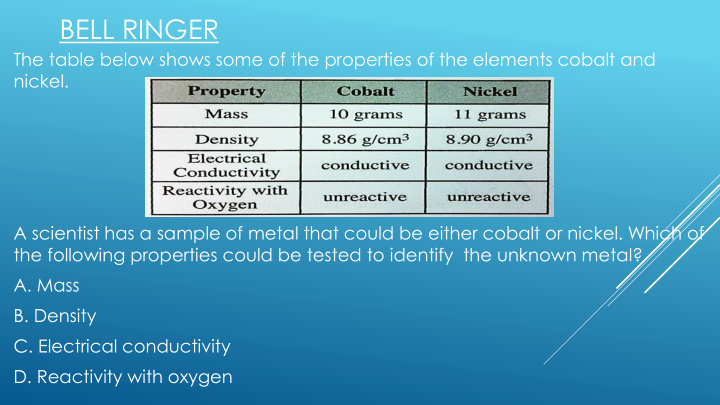



BELL RINGER The table below shows some of the properties of the elements cobalt and nickel. A scientist has a sample of metal that could be either cobalt or nickel. Which of the following properties could be tested to identify the unknown metal? A. Mass B. Density C. Electrical conductivity D. Reactivity with oxygen
PROPERTIES OF MATTER: DENSITY, THERMAL AND ELECTRICAL CONDUCTIVITY SC.8.P.8.4 Classify and compare substances on the basis of characteristic physical properties that can be demonstrated or measured: for example, density; thermal or electrical conductivity; solubility; magnetic properties; melting and boiling points; and know that these properties are independent of the amount of the sample. (Also assesses SC.8.P.8.3 .) ESSENTIAL QUESTION: How can the physical properties of a substance help us reliably identify unknown substances?
INTERACTIVE JOURNAL RIGHT SIDE
MASS VOLUME A MEASURE OF THE AMOUNT A MEASURE OF THE SPACE AN OF MATTER IN AN OBJECT OBJECT OCCUPIES UNITS IN GRAMS, KILOGRAMS UNITS IN CUBIC CEMTIMETERS (CM³) OR MILLILITERS (ML). MEASURED USING TRIPLE BEAM BALANCE.
DENSITY DENSITY IS A COMPARISON OF AN OBJECT’S MASS TO ITS VOLUME. DENSER OBJECTS SINK. LESS DENSE OBJECTS FLOAT. THE DENSITY OF WATER IS 1.0 G/CM³ D = M/V
Density Sample Question: What is the density of a piece of metal if the mass of the metal is 562 grams, and it occupies 44.9mL of space? mass volume What is the density of the metal?
ELECTRICAL CONDUCTIVITY A material that allows electricity to pass through it easily.
THERMAL CONDUCTIVITY A material that allows heat energy to pass through it easily.
COMMON CONDUCTORS METALS are excellent conductors of heat and electricity!
INTERACTIVE JOURNAL LEFT SIDE
BELL RINGER REVIEW The table below shows some of the properties of the elements cobalt and nickel. A scientist has a sample of metal that could be either cobalt or nickel. Which of the following properties could be tested to classify the metal shape? A. Mass B. Density * C. Electrical conductivity D. Reactivity with oxygen
PROPERTIES OF MATTER: SOLUBILITY, BOILING/MELTING POINT, MAGNETISM SC.8.P.8.4 Classify and compare substances on the basis of characteristic physical properties that can be demonstrated or measured: for example, density; thermal or electrical conductivity; solubility; magnetic properties; melting and boiling points; and know that these properties are independent of the amount of the sample. (Also assesses SC.8.P.8.3 .) ESSENTIAL QUESTION: How can the physical properties of a substance help us reliably identify unknown substances?
BELL RINGER Theresa has a pile of sand grains and salt grains mixed together. She wants to separate the sand from the salt. What method can she use to separate these two substances? a) Heat the pile to 100 o C so that part of the pile boils. b) Place a magnet over the pile to pull out the magnetic parts. c) Sift the pile through a screen with holes that are one centimeter wide. d) Stir the pile into a bowl of water, and then pour the water out of the bowl.
INTERACTIVE JOURNAL RIGHT SIDE
SOLUBILITY The ability of a substance to be dissolved into another substance.
SOLUBILITY VOCABULARY: Solute: The substance that is dissolved into the solvent. Solvent: The substance into which the solute is dissolved. Solution: When the solute is dissolved into the solvent. (Homogeneous mixture).
SATURATION POINT Saturation Point: When the solution can’t dissolve any more solute. EX.) the Kool- Aid can’t dissolve more sugar, so it settles on the bottom.
MELTING POINT The temperature at which a substance changes from a solid to a liquid. Melting Point of Water= above 0°C
MELTING POINT
BOILING POINT The temperature at which a substance changes Boiling Point from a liquid to a gas. of Water= above 100°C
BOILING POINT
MAGNETISM A non-contact force that pulls on IRON & NICKEL & COBALT from a distance
INTERACTIVE JOURNAL LEFT SIDE
REVISITING THE BELL RINGER Theresa has a pile of sand grains and salt grains mixed together. She wants to separate the sand from the salt. What method can she use to separate these two substances? • Heat the pile to 100 o C so that part of the pile boils. • Place a magnet over the pile to pull out the magnetic parts. • Sift the pile through a screen with holes that are one centimeter wide. • Stir the pile into a bowl of water, and then pour the water out of the bowl. *
Recommend
More recommend